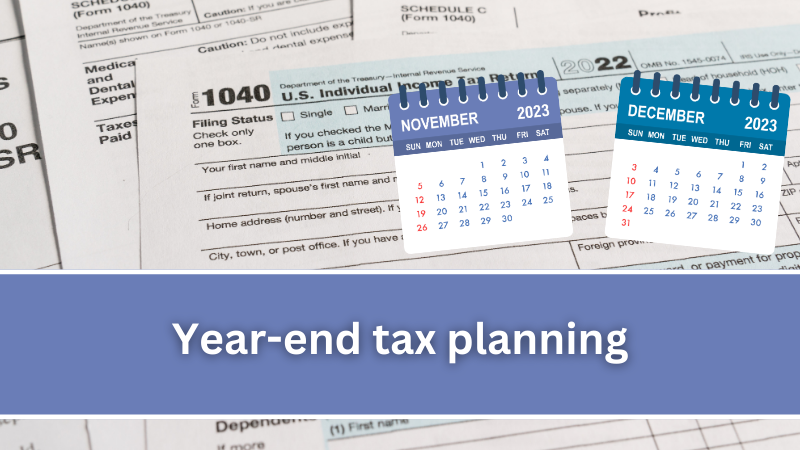Before you know it, we’ll all be saying “Happy New Year!” With the end of the 2023 quickly approaching, it’s a good time think about your financial situation and tackle a few tasks.
Tax planning between now and December 31 can have a significant impact on your ultimate tax bill for the year. But time is slipping through your fingers, so check the list below to get started!
#1 – Check Charitable Donations – Be sure to make all your intended contributions between before year’s end to maximize your charitable giving deduction. If you want to be more savvy in how you support charities, consider a donor advised fund.
#2 – Fund Your Retirement – Maximize contributions to your retirement accounts, such as a 401(k), 403(b), Roth 401(k), etc. The employee maximum deferral contribution is $22,500, plus a $7,500 “catch-up” contribution if you’re 50 or older. For traditional IRAs and Roth IRAs, the maximum contribution is $6,500, plus a $1,000 “catch-up” contribution if you’re 50+. While you’re at it, review your retirement account beneficiary designations to ensure they are still up- to-date.
#3 – Take Your RMDs – Your required minimum distribution (RMD) is the minimum amount you must withdraw from your retirement account(s) each year, although you can always withdraw more without penalty. Thanks to the SECURE Act, however, if your 70th birthday is July 1, 2019, or later, you do not have to take retirement account withdrawals until you reach age 72. So, your first RMD must be taken by April 1 of the year in which you turn 72. After that, your RMD must be taken by December 31 of each year. If you fail to do so, you’ll be hit with a whopping penalty of 50% of the RMD!
#4 – Fund Your HSA – Health savings accounts (HSAs) work alongside high-deductible health insurance plans. If you’re enrolled in an HSA-eligible health plan and meet certain other requirements, you can contribute pre-tax income to an employer-sponsored HSA or make deductible contributions to an HSA you open on your own. An HSA can earn interest or be invested, growing in a tax-deferred manner similar to an IRA. HSA withdrawals for qualified medical expenses are tax-free. For 2023, HSA contribution limits are $3,850 for self-only coverage and $7,750 for family coverage, plus a $1,000 “catch up” contribution if you’re 55+.
#5 – Review Your Investments – Taxes on capital gains can add up. Review your investments now to see if you will have a significant capital gain this year. If so, consider selling an investment on which you have an accumulated loss. You can claim capital losses up to the amount of your capital gains plus $3,000 per year ($1,500 if married filing separately) as a deduction against income.
#6 – Consider Your Income – If you anticipate an increase in your taxable income for 2024, and are expecting a year-end bonus, try to receive it before December 31, 2023. Accelerating income into 2023 is a good idea if you expect to be in a higher tax bracket next year. Conversely, if you expect to have reduced income or to retire in 2024, consider pushing bonuses and other extra income into next year if at all possible.
#7 – Lower Your Business Tax Liability – If you own a business, and are considering buying equipment, furniture, or other “qualified property,” you should consider doing so in 2023 while the bonus depreciation rate is at 80%, because it decreases to 60% in 2024. Additionally, now’s the time to evaluate and write off any bad debts, so you can deduct those too.
With thoughtful planning, you can make the upcoming tax-filing season smooth sailing. Begin gathering your paperwork now, so you’re ready to go when Forms W-2, 1099-Misc and other income documents start arriving in the mail. If you have any questions, we’re here to help — Just contact us at info@sbsaccountants.com or 770-284-5537.

